If you go in the opposite direction in Spitz in the Wachau, i.e. neither southwest to the few remaining Benedictine monks in Melk nor down the Danube and past the vineyards of Wösendorf, Weissenkirchen and Loiben, you take the third path past the cycling and walking masses, then you end up in the Spitzer Graben. The Burgberg - better known as the 1000-Eimer-Berg and Riesling monument at the end of the Wachau - and the crescent-shaped relay from the Setzberg to the Singerriedel obscure the view into the Waldviertel and the Graben, and anyone who is satisfied with their imposance will miss out on some of Austria's most spectacular vineyards, an innovative and differentiated winegrowers' scene that is impressive in its density, and the realisation that the Wachau certainly does not end here, but only far beyond the Burgberg.
At an altitude of 200 metres, the Graben begins at the end of Spitz, but unlike the Danube Wachau, it gradually winds its way up. Over seven kilometres, you climb a whopping 160 metres to Viessling and Elsarn, its last two wine villages. To the left, always accompanied by the Jauerling, the 1000-metre-high ski paradise of the lowlanders and eminent climate factor of the Graben winegrowers, to the right, on the eastern side, by the wildest vineyards of the Wachau, the Zornberg, the Kalkofen, the Spitzer Biern and the Schön to the most famous vineyard, the Riede Bruck.
 |
| Photo: Dominik Portune% weinundtext |
If you know the Graben, it is here, at the end of the Wachau, that you always notice a man who toils in the terraces in wind, weather, sun, rain, snow and hail. "That's the father," says Josef Högl, the winemaker who has probably made the most significant contribution to the Graben's upswing and its current reputation. "If he didn't have to eat and sleep occasionally, he probably wouldn't come home at all." 25,000 vines stand on the Högl terraces, and "the father knows them all. He grew up with some of them, on the Bruck and the Schön we have 50 to 60-year-old vines, he lives there during the day. He has never really been interested in the cellar."
So for a long time, his father only delivered grapes to the cooperatives - like everyone else at the time, bottling was only for his own needs. This only changed when Josef Högl fully joined the company, which was preceded by many years of apprenticeship and a few years of wandering. However, he only wandered as far as Weissenkirchen. There Franz Prager, the Wachau white wine pioneer of the first hour, took him under his wing. For ten years. For his first wage, he bought a 1,000-litre tank, which he still uses today. Later he wandered a little further to Oberloiben, where he worked with F.X. Pichler pressed wines for history. And then, in 1995, back to Viessling, to the home estate, in the shadow of the Bruck and Schön. "In total, there were three to four hectares, and these had to be cultivated with all our strength and concentration." A few hectares were added later and with them, for the first time, an examination of the qualitative perspectives of the ditch.
The Spitzer Graben is at the limit of what is possible. Climatically and topographically. Separated from the Donauwachau by only a few metres, much is different here. The conditions are harsher, the reading later, the terraces steeper, rain also falls more often - and the people are more reserved, more reserved, often a Spiegel of their wines. Little is clear here at first glance, except that one is dealing with the extremes of viticulture.
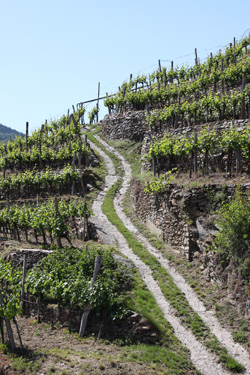 |
| Photo: Dominik Portune% weinundtext |
If you stand on the crest of the Bruck or Schön, you can't see its foot. If you look up from below, you marvel at the countless dry-stone walls that hold up the mountain. The humus layer is thin, especially in the higher, windier areas, through which slate glistens again and again. Of course, these extremes shape the vintner and the wine. And they often only become clear through comparison. "We also have a few vineyards over in Loiben, 20 kilometres away, where we planted Rieslings, and at first I wanted to make ice wine there, too," Högl says. "So in the middle of winter I got up at four o'clock in the morning for three days, looked at the thermometer, read minus nine degrees, sat in the car, and then read in Loiben. There it was then minus four degrees, too warm for ice wine, and I drove back, with empty and cold fingers."
Peter Malberg can also sing a song about the differences that open up from Loiben to the furthest corners of the vineyard. As a career changer in the Graben, he has owned small parcels of land for a few years now, stretching from one end of the Wachau to the other. This opens up a holistic view and the realisation that you can be dealing with completely different conditions within a few kilometres. "You have to get to know the sites over the years," he says, adding that in principle there is immense quality potential in the Wachau vineyards. "It only changes permanently due to people and weather" as well as the fact that one constantly observes and learns.
Malberg has learned quickly. His range of wines is impressive - even in a delicate vintage like the last one - and represents the independence of the different sites. He does not make things easy for himself. He works decidedly organically (and only not biodynamically because he does not have his own livestock for fertilisation), relies on core ripeness instead of sugar ripeness and thus undermines the classic and categorical Wachau concept of hierarchisation via alcohol gradation. "I'm not interested," he says, "more important to me is the state of the style framework, the foliage, the looseness of the berries, their taste." Other winemakers in the Graben see it similarly, but no one declares it as consistently as Peter Malberg. The former cellar master of Schloss Hardegg forms the avant-garde of the Spitzer Graben with his ideas and methods and yet remains deeply traditional.
He listens to the grape, just as the monks in Burgundy did generations ago, who are said to have even tasted their soil. Malberg is not far from that, and when he sticks his hand into the oat-covered soil of his plot on the Bruck, he contentedly pulls fauna and flora out of the ground with him. No tractor drives in here, and so no soil compacts. The garden is alive and so are the wines.
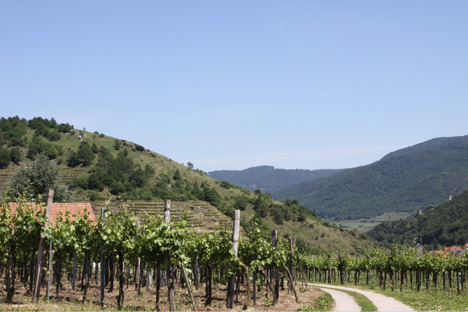 |
| Photo: Dominik Portune% weinundtext |
The wines are Veltliners and Rieslings from a total of six vineyards, and to do them justice, Malberg meticulously follows a philosophy that has grown over the years. He ferments spontaneously and always without botrytis "to reflect the character and originality of the vineyard", he harvests astonishingly early, simulates an old tree press with a modern press, crushes extremely gently and slowly and allows the musts to oxidise a little so that the wine does not need any more sulphurisation afterwards. In addition, fermentation takes place at warm temperatures. Although this promotes the individuality of each vintage, it can also cause headaches at the beginning because the primary fruit aromas evaporate. This was the case in 2010: "From Christmas until the end of January I didn't taste the wines, I was frustrated, nothing fit, no harmony, no fragrance," Malberg confesses.
That has changed since then, of course. The GV Kreutles, which Malberg calls his boozy wine, is precise, clear, harmonious and playfully light, the Veltliner from the Hochrain is dense, almost Burgundian, mineral, long and yet extremely drinkable, and the other Veltliners from the Weitenberg and Loibenberg are well-balanced, spicy, powerful and juicy. And that even after 14 days. Peter Malberg focuses on sustainability. Not only in the vineyard, but also in the wines. And so it happens that his Rieslings from the Buschenberg and the Bruck still demonstrate their filigree and fine aromas after two weeks, maintain their balance and sometimes reveal themselves even better than in the freshly opened stage.
A few hundred metres into the graben and always nicely uphill, in Laaben, Johann Donabaum cracks open a bottle of GV Federspiel Spitzer Point. He, too, first reflects on last year's vintage and sees it with the typical pragmatism and stoic fatalism of the Graben vintners. It was cold for a long time, it rained a lot, the blossom came late, and losses in volume were foreseeable early on. But these are situations that winemakers far from the Danube have to deal with time and again, and perhaps that is also the reason why the wines are brilliant across the board this time as well. They are tighter, a little more austere, but also mineral and long - never expansive, but rather on their way towards the palate as if on rails. "Due to the modest fertilisation, there was no trouble with botrytis throughout the year. This in turn allowed maceration times of up to one day - the tartaric acid is thus lower, the wines richer in extract. In the end, we had less than six parts per thousand acidity in the Veltliner", and in general the wines appear perfectly structured, crystal clear, with filigree fruit and extremely precise.
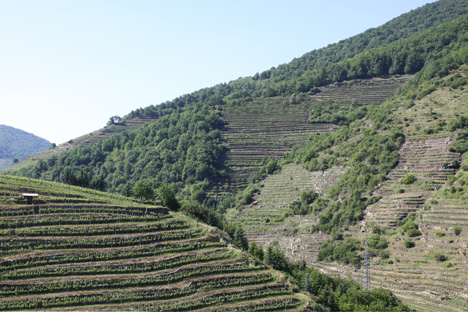 |
| Photo: Dominik Portune% weinundtext |
Leaning back and watching the sun shine is not part of the everyday life of the local winegrowers anyway. Something always happens. This was also the case in 2009, when the gently babbling Spitzer Bach turned into a raging torrent, tore away the small access bridge to the winery and flooded the Donabaum cellar. The bottles were washed through the area, leaving behind a huge chaos of unlabelled wines that Donabaum passed on to regular customers as flood wines. They didn't know what was inside, but they knew they could rely on the quality of their winemaker. This was also confirmed last year by the Decanter. Perhaps the most important wine magazine in the world awarded the Trophy to the Riesling Smaragd from the Setzberg 2007 on the occasion of the annual competition and in long blind tastings and thus as the best Riesling of the event.
Leaning back, Johann Donabaum looks at the sun and talks about the Graben. About the day-night differences that give the wines a compact, firm body, about the generally late harvest, which is often completed 14 days later than out on the Danube and then often not until November, and about the different sites and their soils, the Setzberg resting on limestone, the scree from Spitzer Point and the slate inclusions on the Offenberg (clear and fresh like the Spitzer Bach, steely like a knife blade and a fruit that lingers on the palate for a few minutes). Of the fact that the climate and topography have always set the tone here. The best sites, the emerald sites, are therefore not at the very top, but similar to Burgundy in the middle, up to an altitude of 350 metres.
And he concludes that, as different as the individual concepts of many winemakers may be, in the end they often pull together. Together with his friend Friedrich Rixinger, Donabaum had the idea of turning the entire ditch into a pest-free zone by applying pheromone dispensers. An undertaking that, although there is little talk in the Spitzer Graben, was so convincingly demonstrated that since then the application of insecticides has become a thing of the past.
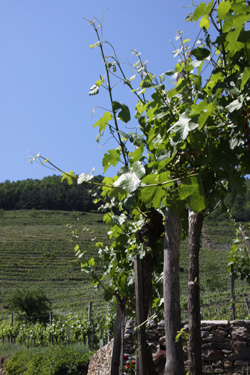 |
| Photo: Dominik Portune% weinundtext |
His buddy, Friedrich Rixinger, is not a vintner of big words either, but the wines he presses speak for him anyway. And besides, as Josef Högl already pointed out as a walking example, the winemakers here are a bit like their wines - they need a little while to blossom. A few hundred metres further up the Spitzer Graben, in Gut am Steg, you can see the Kalkofen, the Zornberg and the Spitzer Biern towering into the sky, three wild steep slopes that can only be cultivated by hand - and a swallow in the room. It circles over the tasting glasses and sees a sparkling clear GV Federspiel from the Zornberg from above. And as it slowly soars right up there, so much spice and grapefruit rises from the glass that, quite simply, you are dealing with a paradigmatic Veltliner - the potential dream of every Weinvierteler.
The wine then immediately opens the Q&A session, and Friedrich Rixinger readily provides information about his three spectacular sites. The Zornberg, he says, is made for Veltliner: the soils are sandy and deep, eroded weathered soils that offer everything a Veltliner likes, since his sites are located on a two to three hectare plateau.
Of course, it was not always there. Until not so long ago, the Spitzer Graben was Neuburger terrain. The planting density was up to 90 percent, and there were good reasons for that. The Neuburger is a deep-rooted plant and even in the driest years it fetches the water it needs from the depths. When an irrigation system was approved in 1993, the successive switch to Riesling and Veltliner was also sealed. In the Kalkofen, however, there are still 50-year-old vines (in addition to some young ones that he has replanted against the trend), from which Rixinger makes his Neuburger X, a mineral, cool wine with a subtle sweetness in the background and a filigree fruit in the foreground. In addition, however, there is also an excellent Riesling from there, a terroir wine, mineral and fruit-precise, as Rixinger says, adding that "after 40 centimetres you come across stone right away and the terraces, which stretch up over 100 metres in altitude, are often only 1.5 metres wide." The Spitzer Graben is, that much is certain, a valley of extremes.
"We have to explore them," says Josef, alias Graben Gritsch, and lets his gaze wander over the Schön and Bruck vineyards before pointing behind the house. There, at the foot of the Jauerling, he recently planted Gewürztraminer and "no one has ever done that before. Why? "Well, that the climate is slowly changing is a fact that you should simply accept if you have grown up here. If you do, you also have to react."
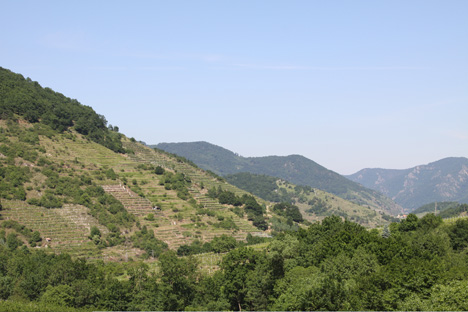 |
| Photo: Dominik Portune% weinundtext |
The view from his terrace, by the way perhaps the most beautiful in the whole Graben, goes back to the classic vineyards and, having become thoughtful, lingers on the dry-stone walls. Generations of winegrowers have worked on them, they decisively shape the landscape of the Wachau and make viticulture in these steep slopes possible in the first place. "Nothing works here without walls," Gritsch tells us, "but the increasingly intense storms are often too violent even for the best wall." He repairs 200 to 300 square metres of masonry per year, two months of his winemaking work are dedicated to the preservation of the Wachau cultural landscape. In the past, this was subsidised, the EU paid 60 euros per square metre, but those days are over, and the Ministry of Agriculture and the tourism businesses turn a deaf ear. If nature is left to its own devices, however, the terraces soon become overgrown, bushes and shrubs take over, and with them come birds and deer. Peter Malberg already gave up a terrace because the deer ate away all his grapes. "If I were to hire a contractor," Josef Gritsch continues, "it would break my annual turnover." So he continues to restore himself. But everywhere in the ditch you can also see dilapidated masonry, abandoned terraces mostly belonging to part-time farmers and cooperative members who, increasingly elderly, no longer have the desire or strength to keep repairing the walls and cultivating the plots.
The Spitzer Graben has the highest density of cooperative members in the entire Wachau. This is also noticeable when you walk along the gardens. Signs tell about it. Muskateller here, Neuburger there. Most of the grapes form the backbone for Domäne Wachau's terraced cuvees, but since winery manager Roman Horvath and cellar master Heinz Frischengruber took over the cooperative helm, the focus has increasingly been on the vinification of single vineyard sites. Horvath, one of two Austrian Masters of Wine, knows about the extravagance of the trench: "We really scratch the limits of viticulture the further back it goes. The soils are barren and stony. The wind whistles through and the formation as a valley basin leads to rapid cooling. Ultimately, it's special microclimates in hillside hollows that allow the vines to thrive." Domäne Wachau vinifies two wines separately in the Spitzer Graben: one at the very back, the Riesling Federspiel von der Bruck, clear, taut and cool; and one at the very front, the Traminer vom Setzberg, perhaps the best Traminer in the entire Wachau, floral, dense, aromatic and compact. Horvath also highlights a site that he believes is underestimated, Trenning, the rearmost and highest, though sunniest, site of the Spitzer Graben.
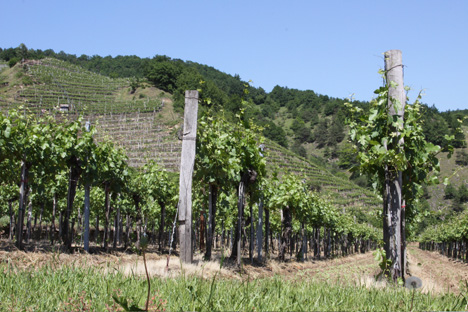 |
| Photo: Dominik Portune% weinundtext |
The Trenning can also be seen from Josef Gritsch's terrace. He has no vineyards there, but he shares Horvath's view and even extends it further. In the Spitzer Graben, he says, one has by no means reached the end, and yet everyone must first master what they are currently cultivating. Gritsch does this in an impressive and typical way for the Graben. With as much organic as possible in the vineyard, botrytis-free grapes (he has his own line in which he vinifies grapes with noble rot separately), which in his view bring about better and positive ripening, with warm fermentation temperatures and long maceration times, which buck the trend towards drop-like wines, but above all with a commitment to the natural environment. The techniques are conservative and often traditional, but they also lead to the declared goal of making authentic wines that emphasise terroir.
The word terroir is rarely used here, although perhaps nowhere in Austria is it more justified than in Graben. Perhaps precisely because of this. There is no plain in the whole of Graben, the conditions, soil and climate, permanently shape it and do not need to have the stamp of terroir continually put on them. It is there anyway and everyone is aware of it. "We know that we have potentially less sugar here than in Weissenkirchen, but we also know how to deal with it." The goal is generally elegance and finesse, a Gothic structure, not, as is often the case out on the Danube, force and opulence, the Baroque counterpart. And this gothic structure, despite the generally high acidity, results in small masterpieces, multilayered and nuanced, crisp but complex.
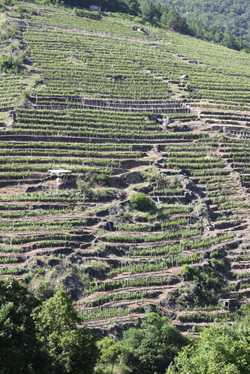 |
| Photo: Dominik Portune% weinundtext |
The Hauerjause of Frau Muthenthaler is also multi-layered, layers of bacon and cheese, spreads and pickles. When you arrive in Elsarn, the last wine-growing village of the Spitzer Graben, you need these culinary layers. And as innovative as the wine scene may be, with a view that extends far beyond the country's borders, to the export markets in Scandinavia, the USA or Japan as well as Austria's top gastronomy, the local roots, the Heuriger and its social component are also elementary. So every few months, the winery of Martin Muthenthaler, the youngest star in the Graben sky, also offers plump plates and the opportunity to taste his four wines. The former driver of the Domäne Wachau calls a whole three hectares his own, all of them organically farmed, all of them located in the steep vineyards of Bruck and Schön, and in the Brandstatt, the ultimate challenge to winemakers, as steep as the Kitzbühel mousetrap. Peter Malberg has started restoring some plots there, and Muthenthaler would like to do the same as his friend from the other side of the moat. But he also knows about his capacities. For the time being, three hectares of these extreme sites are all he can cultivate alone. But for no other winegrower are the signs pointing to a new beginning as much as for Muthenthaler. So he dreams, and that is of course always legitimate. Of a few more terraces, but also of really wild wines. Today, with his subtle, mineral, compact and finely chiselled wines, he is already in line with the trend of the best Graben winemakers, but he has other things in mind. In his search for the ultimate wines, he stumbled across the mash-fermented Rieslings of Peter Jakob Kühn in the Rheingau and the hyper-fermented white wines of the Friulian Karst winemakers. Since then, similar ideas have been running through Muthenthaler's head. "Fermenting a Riesling through on the mash has never been done in the Wachau. But at some point, when..."
Muthenthaler is bubbling over with enthusiasm, but he also knows about the difficulties of establishing himself in the first place. In the furthest corner, where the Wachau really ends, it is not easy in this respect. Tourists rarely lose their way here, and so he currently has to live with the attribute of being an insider tip.
Josef Högl has been rid of that for some years now, at the latest since he was named Winemaker of the Year by Falstaff in 1998. And yet, especially in the periphery of the Wachau, it is important to keep working on quality and innovation. He no longer makes ice wine, but many of his other ideas, which he has always consistently pursued, have borne fruit.
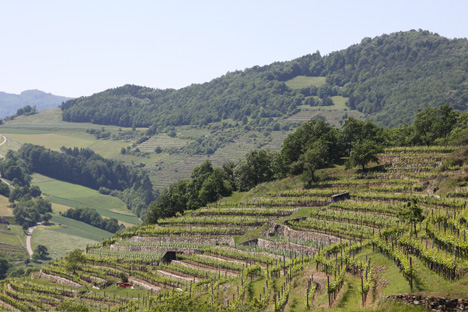 |
| Photo: Dominik Portune% weinundtext |
These rarely have to do with improved technologies, but rather with precise observations of the given environment. "In the Spitzer Graben, we are aware that the conditions are more sensitive," says Högl. But it is precisely this climatic tightrope walk that also makes the wines unique - taut and austere, precise and mineral. The soils also ensure this. Less gneiss than in the Danube terraces is found here, rather we are dealing with slate, the foundation for elegance, both in the Riesling and the Veltliner.
"The long relationship with our vineyards requires a detailed knowledge of our terroir," Högl continues and sums up the dilemma of digging one last time: "We know that we often have to go out later for the harvest and that there are years when we have three harvest runs and only cut the last grapes from the vines in December. We know that there are always problems with botrytis in late summer because the east wind does not blow, or that the Waldviertel clouds often burst on the Jauerling and rain down on us. But we know how to deal with it, we only have to irrigate in extreme years, we use the rain to cover crop our terraces and protect the steep slopes from erosion."
On one of these steep slopes, high above the Högl house, the father is standing again, this time in rain boots. He knits the shoots through wire frames, and after a short while the son also says goodbye and climbs up through the Bruck into his vineyard.
The following wineries from the Spitzer Graben are mentioned in the article and most of them also have currently wines for tasting:
Domäne Wachau in the Wine Guide
Winery Johann Donabaum in the Wine Guide
Winery Josef Gritsch - "Graben-Gritsch" in the Wine Guide
Winery Josef Högl in the Wine Guide
Winery Martin Muthenthaler in the Wine Guide
Winery Friedrich Rixinger in the Wine Guide
Winery Veyder-Malberg in the Wine Guide
The following wineries from the Spitzer Graben, which are not mentioned in the article, also have currently wines for tasting:
Winery Gritsch - Mauritiushof in the Wine Guide
Winery Rupert & Erika Gritsch in the wine guide
Winery Schneeweis in the wine guide
The following wines from the Wachau region were currently tasted and rated:
All currently tasted wines from the Wachau in the Wine Guide